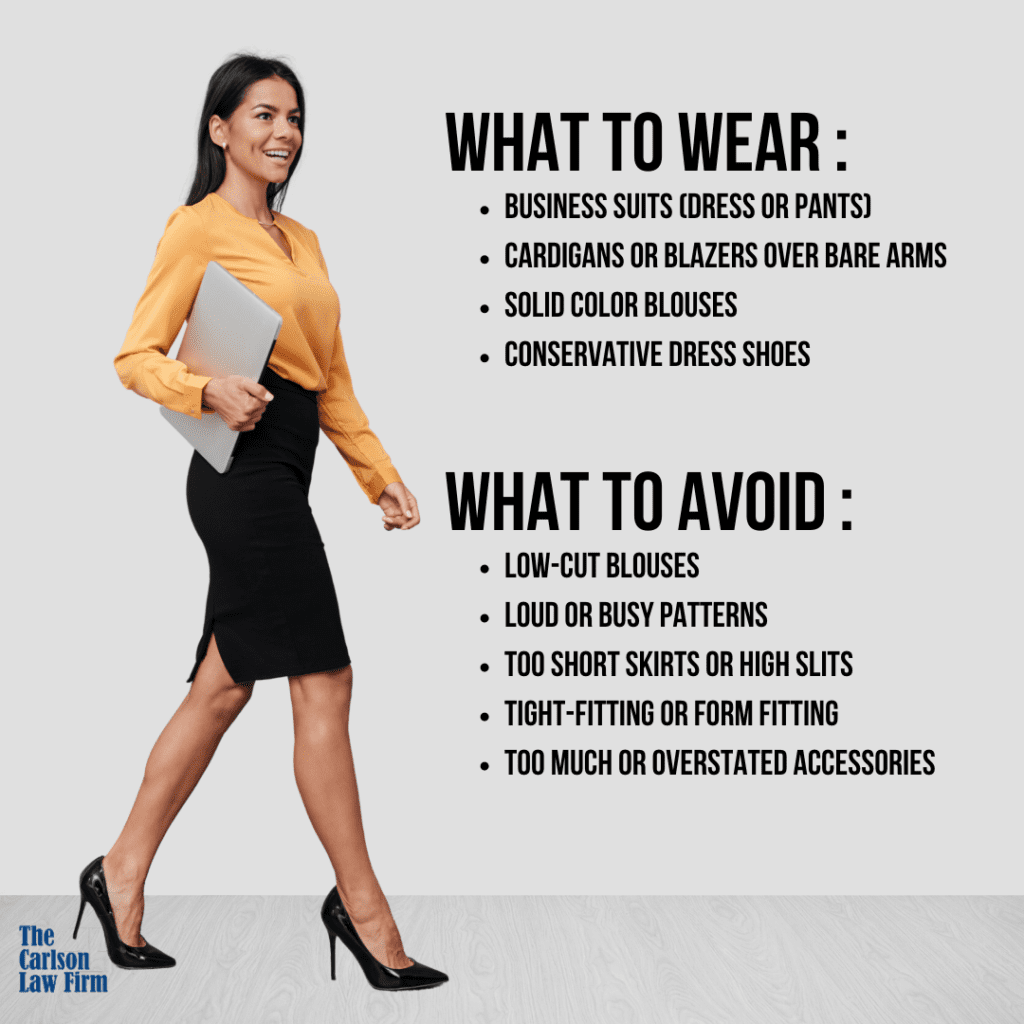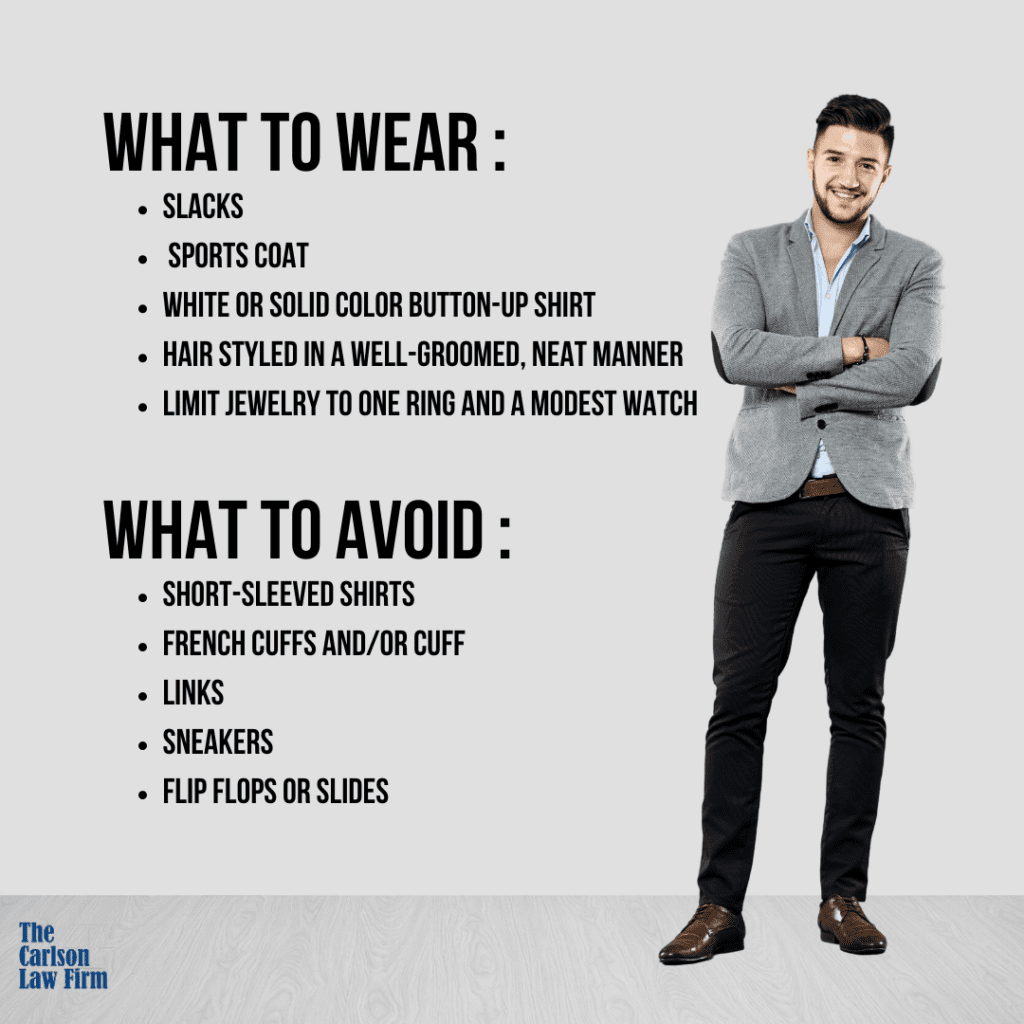With 65.2 million Hispanics living in the United States by 2024, this demographic group is…
If you’re Googling “what to wear to court?” it’s likely that you have a court date on the horizon. Most people will have to appear before a judge at some point in their lives. In fact, approximately 100 million cases are filed each year in state trial courts and 400,000 in federal courts. Whether you are fighting a speeding ticket or fighting for your rights in a child custody case, it’s important to note that the proper courtroom attire actually does matter. Your appearance when you arrive in a courtroom communicates whether or not you take the matter seriously.
No one wants to be judged solely on their appearance and they shouldn’t. But in a courtroom, your appearance underlines the argument your attorney is making on your behalf. It is important that you put the best you forward when you appear before a judge and jury. Remember a few do’s and don’ts when appearing before a judge.
Do courtrooms have dress codes?
Yes, some U.S. courts may require a certain dress code and explicitly forbid clothing deemed inappropriate. Many courts state that persons entering the courtroom be properly attired. So, it’s essential to know if the court in which your case is being heard requires a dress code. Typically, courts have this information available on their websites or you can consult with your attorney.
Still, even if a court does not require a specific dress code or forbid certain items, you want to remember the value of first impressions.
While the notion of first impressions may seem like an archaic way of thinking in a society moving closer to acceptance, courtrooms still place significant meaning on appearance and etiquette. This applies to everyone entering a courtroom, including attorneys, plaintiffs, defendants, and even spectators.
Why does your appearance in a courtroom matter?
When judges and juries determine credibility, appearance is one of their biggest influences. A judge is much more likely to believe what you’re saying if you show up to court in a nice blouse and slacks than if you appear in Cookie Monster pajama pants. For example, if Child Protective Services accuses you of neglect, showing up to court in a nice suit and groomed hair will convey that you take care of yourself, so you’re capable of taking care of others.
Pro Tip on What to Wear to Court: Dress like you have respect for the court
Whether you’re going to be a witness, juror, plaintiff or defendant, your favorite t-shirt is not the place for a courtroom. The general rule of thumb when going to court is you should dress conservatively. Second to arrive on time, how you dress is important to show the judge you respect the court and its time. Over the last two decades, the standard of dress in courthouses seems to have declined. However, just because you see others in sweatpants and fuzzy slippers walking around the courthouse doesn’t mean you should commit this same fashion crime.
What to wear to court for women?
When you walk into a courtroom, the goal is to look professional and trustworthy.
Women should dress business or business casual. Wearing the following will make a good impression in a courtroom:
- Business suits (dress or pants)
- Cardigans or blazers over bare arms
- Solid color blouses
- Conservative dress shoes
Finally, hair should be neatly groomed. Long hair should be pulled away from the face. This will help avoid distracting or nervous behaviors.
Women appearing in a courtroom should avoid:
- Low-cut blouses
- Loud or busy patterns
- Too short skirts or high slits
- Tight-fitting or form-fitting
- Too many or overstated accessories
 What to wear to court for men?
What to wear to court for men?
Men don’t have to break the bank for a brand new suit when they make appearances in court. While a suit and tie are the best choices, they aren’t the only choices. Men also have the option to wear business casual.
When making an appearance in court, men should wear
- Slacks
- Sports coat
- White or solid color button-up shirt
- Hair styled in a well-groomed, neat manner
- Limit jewelry to one ring and a modest watch
Men appearing before a judge should avoid:
- Short-sleeved shirts
- French cuffs and/or cufflinks
- Sneakers
- Flip flops or slides
Neither men nor women should show up to court looking disheveled. It’s important to remember that you never get a second chance to make a first impression. If you’re unsure about what to wear to court, consult with your attorney.
Overall Dos and Don’ts When Choosing an Outfit for Court:
Be Careful with Color
It’s best to avoid bright colors. Whether you’re a plaintiff or a defendant, dark or neutral colors like white, navy blue, and gray are the best colors to wear to court. Your attorney can offer guidance if you’re unsure about what you’re wearing.
Why does the color of my clothing matter?
There is significant research on the psychology of colors. Colors can shape the feeling someone has when they see them. For example, bright and loud colors can signal intensity and aggression—two emotions you want to avoid in court.
Experts recommend that the best colors to wear to court convey stability, practicality and innocence.
Avoid Jeans and Shorts at All Costs
This applies to plaintiffs, defendants, witnesses, and even spectators: do not wear jeans or shorts to court! Modern trends tend to lean toward comfort over style. Unfortunately, these items do not convey respect for the court. They will send the wrong message to the judge and jury.
Rather than jeans, focus on wearing slacks, skirts, or khakis. Make sure there are no holes; they fit well and are wrinkle-free.
Say Bye to Your Crocs for a Few Hours
Remember the note about comfort above that we made about pants? Yeah, that applies to your shoes as well. Avoid tennis shoes, sneakers, sandals, and Crocs when you’re headed before the judge and jury. Wear closed-toe dress shoes.
Brush and Style Your Hair
While we don’t care about messy buns, baseball caps, bedheads, or bonnets at the mall or airports, a court will care. Much like the rest of your outfit, your hairstyle needs to communicate that you take your situation seriously.
The Carlson Law Firm Can Help
While it may seem small compared to your legal situation, what you wear can affect the outcome of your case. If you’re appearing before a judge, it doesn’t necessarily mean you must wear a suit and tie. However, if you show up in flip-flops and sweatpants, the court may get the impression that you don’t really care about your situation.
No matter your legal needs, The Carlson Law Firm has an attorney ready to assist.



